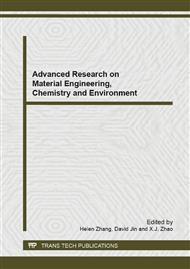p.405
p.409
p.413
p.418
p.422
p.428
p.434
p.440
p.444
Bioremediation of Nitrobenzene Contaminated Groundwater by a Mixed Culture
Abstract:
In this experiment, solid biological agents were used for the degradation of the nitrobenzene contaminated groundwater. Degradation characteristics of the strain under the different conditions, such as concentration of nitrobenzene, cultured temperature, pH and rotary speed were studied. Results showed that when the concentration of nitrobenzene was 200mg/L, the degradation rate was highest, which was reached to 99.5%. The optimum cultivation conditions of the consortium for the growth temperature, pH and shaker rotary speed, which obtained the strongest rate of nitrobenzene were 10°C, 7 and 120 r/min, respectively and we can see from the result of DGGE that each lane contained bands are more and contained diversity of strains.
Info:
Periodical:
Pages:
422-427
Citation:
Online since:
September 2013
Price:
Сopyright:
© 2013 Trans Tech Publications Ltd. All Rights Reserved
Share:
Citation:


